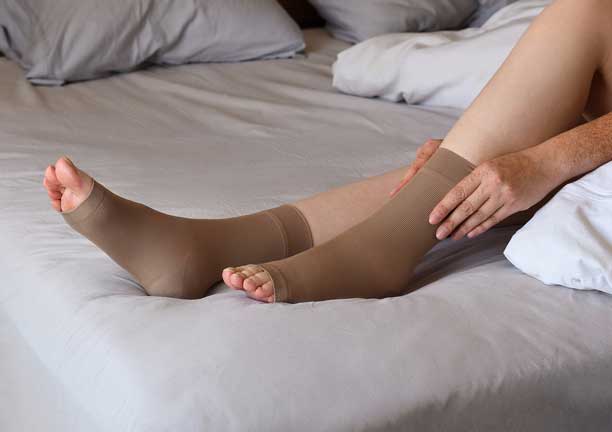
Compression socks are an essential tool for many individuals, whether they’re used for medical purposes, athletic performance, or everyday comfort. These specially designed socks provide graduated compression to improve circulation, reduce swelling, and enhance recovery. However, just like any piece of clothing or equipment, compression socks do not last forever. Over time, they can lose their elasticity and effectiveness, rendering them less beneficial for your health and comfort.
In this comprehensive guide, we will explore when to replace compression socks, how to extend their lifespan, and the signs you should watch for to ensure that your socks continue to provide the support they were designed for. Whether you’re using compression socks for medical reasons, sports recovery, or general leg health, knowing when it’s time to replace them will help you maintain their optimal performance and prevent potential foot or leg issues.
1. What Are Compression Socks and Why Are They Important?
Compression socks are designed to apply gentle pressure to your legs and feet, which improves blood flow and supports the venous system. This pressure is stronger at the ankle and gradually decreases as it moves up the leg, a design known as graduated compression. Compression socks come in different compression levels, measured in millimeters of mercury (mmHg), ranging from mild to high compression, depending on the needs of the wearer.
Compression socks are used for various reasons, including:
- Medical Use: Compression socks are commonly prescribed to individuals with conditions like varicose veins, deep vein thrombosis (DVT), edema, or poor circulation. They help prevent blood from pooling in the veins and improve circulation.
- Athletic Performance: Many athletes wear compression socks to reduce muscle soreness and improve recovery times. They are also known to reduce the risk of injury during intense physical activity by enhancing blood flow to muscles.
- Everyday Use: Compression socks are often worn by people who stand for long periods, such as nurses, teachers, or office workers. They can help alleviate discomfort, reduce swelling, and prevent fatigue in the legs.
Given the benefits compression socks provide, it’s essential to ensure that they maintain their functionality. Over time, however, they lose their ability to provide consistent compression, which is why it’s important to know when to replace them.
2. Signs It’s Time to Replace Compression Socks

Compression socks are designed to be durable, but they are not immune to wear and tear. The pressure they apply diminishes over time, and if you wait too long to replace them, they may not provide the benefits you rely on. Below are the most common signs that indicate it’s time to replace your compression socks:
2.1. Loss of Elasticity
The most noticeable sign that your compression socks need replacing is a loss of elasticity. Compression socks rely on the tightness of their material to apply the right amount of pressure to your legs and feet. Over time, repeated use, washing, and stretching can cause the fibers to lose their ability to “snap back.” When compression socks no longer feel snug and supportive, they won’t provide the intended benefits, such as improving circulation and reducing swelling.
2.2. Visible Wear and Tear
Compression socks are subjected to a lot of stress, particularly around the areas that experience the most friction, such as the toes, heels, and the area above the ankle. If you notice any visible signs of wear, such as thinning fabric, fraying, or small holes, it’s a clear sign that the socks are no longer as effective. Even if there is no hole yet, thinning fabric means the socks have lost their integrity, and their compressive ability will likely be compromised.
2.3. Decreased Compression Effectiveness
The primary reason you wear compression socks is to benefit from their ability to improve circulation by providing graduated compression. However, over time, the materials that provide this compression may break down, reducing their effectiveness. If you notice that your socks no longer feel as tight or supportive as they once did, or if you no longer feel the same level of relief from swelling or discomfort, it’s likely time to replace them.
2.4. Fading or Discoloration
Compression socks are often made of materials like spandex, elastane, or nylon, which are prone to color fading after repeated washing. While fading doesn’t necessarily affect the compression quality directly, it is a sign that the fibers have been exposed to wear and tear, which can weaken the sock’s overall performance. Moreover, discoloration could indicate that the socks are losing their moisture-wicking properties, which are essential for keeping your feet dry and preventing fungal growth.
2.5. Difficulty Keeping Them Up
Compression socks are designed to stay in place throughout the day, applying pressure evenly to your legs and feet. If your socks start to slip down or bunch up around the ankles or calves, it’s a sign that the elastic in the socks is no longer holding them in position. This not only reduces their effectiveness but can also lead to discomfort, as loose socks may cause chafing and irritation.
2.6. Odor and Hygiene Issues
Compression socks are worn for long periods, and because they often help wick away moisture from the skin, they can accumulate sweat, dirt, and bacteria. Over time, the fabric may become less effective at moisture-wicking, leading to unpleasant odors that don’t wash out. If washing your socks no longer eliminates the smell, this could be a sign that the fabric has degraded and needs to be replaced.
3. The Importance of Replacing Compression Socks Regularly

Compression socks play a critical role in maintaining leg health, improving circulation, and reducing swelling. If the compression levels decrease, the socks can no longer provide the benefits they are meant to. Regularly replacing your compression socks ensures that you receive the full therapeutic effect, helping to prevent discomfort, leg fatigue, and more serious conditions like deep vein thrombosis (DVT) or varicose veins.
Here are some reasons why replacing your compression socks at the right time is crucial:
3.1. Continued Circulation Support
Compression socks work by improving circulation in the lower legs. If the socks lose their ability to provide graduated compression, they won’t have the intended effect. This can lead to poor circulation, resulting in swelling, fatigue, and even more serious health issues. Replacing your socks when they lose elasticity helps maintain good blood flow to your legs and feet.
3.2. Avoiding Further Health Complications
Worn-out compression socks can contribute to poor circulation, which increases the risk of developing serious health problems like varicose veins, edema, or blood clots. If you rely on compression socks for medical reasons, such as managing venous insufficiency or preventing DVT, it’s essential to replace them regularly to prevent complications.
3.3. Maximizing Comfort and Recovery
Compression socks also help athletes recover by reducing muscle soreness and promoting faster recovery times. If you use compression socks after workouts or for long periods of standing or sitting, replacing them ensures they continue to support muscle recovery and reduce fatigue. Worn-out socks can leave you feeling uncomfortable and less supported during activities.
3.4. Preventing Skin Irritation
Old compression socks with loose fabric or worn-out seams can lead to skin irritation, chafing, or even blisters. Properly fitting socks that offer consistent compression will help you avoid these issues and ensure that your legs and feet stay comfortable all day.
4. How Often Should You Replace Compression Socks?
The lifespan of compression socks varies depending on how frequently they are worn, how well they are cared for, and the level of compression. However, here are some general guidelines:
- Every 6-12 Months: For individuals who wear compression socks daily or for long periods, it’s generally recommended to replace them every 6 to 12 months. Over time, the elasticity will degrade with regular use.
- Every 3-6 Months: If you wear your compression socks for intensive physical activity, such as running or cycling, it may be a good idea to replace them every 3 to 6 months. The constant stretching and washing can cause the fabric to lose its effectiveness sooner.
- When Signs of Wear Appear: If you notice any of the signs of wear mentioned earlier (loss of elasticity, holes, discoloration, etc.), it’s time to replace them, regardless of how long you’ve had them.
5. Tips for Extending the Lifespan of Your Compression Socks
While compression socks need to be replaced periodically, there are steps you can take to extend their lifespan and get the most out of them:
- Wash Properly: Always follow the manufacturer’s care instructions. Wash your compression socks in cold water, preferably by hand, or use a gentle machine cycle with a mesh bag. Avoid using fabric softeners, which can break down the elastic fibers.
- Air Dry: Avoid using a dryer to dry your socks, as high heat can damage the fabric. Instead, lay them flat to air dry.
- Rotate Pairs: If you wear compression socks regularly, try to have multiple pairs so that you can rotate them. This reduces the wear and tear on any one pair and helps extend their lifespan.
6. Conclusion
Compression socks are a valuable tool for improving circulation, reducing swelling, and enhancing recovery. However, they are not indestructible. Over time, the compression provided by your socks will degrade, and they may show signs of wear and tear. Regularly replacing compression socks ensures that you continue to reap the benefits of improved circulation, comfort, and recovery. Be sure to watch for signs like loss of elasticity, visible wear, decreased compression, and difficulty keeping them up, as these are clear indicators that it’s time to invest in a new pair.
By following proper care guidelines and replacing your compression socks when needed, you can continue to enjoy their health benefits and keep your legs
RELARED POST
